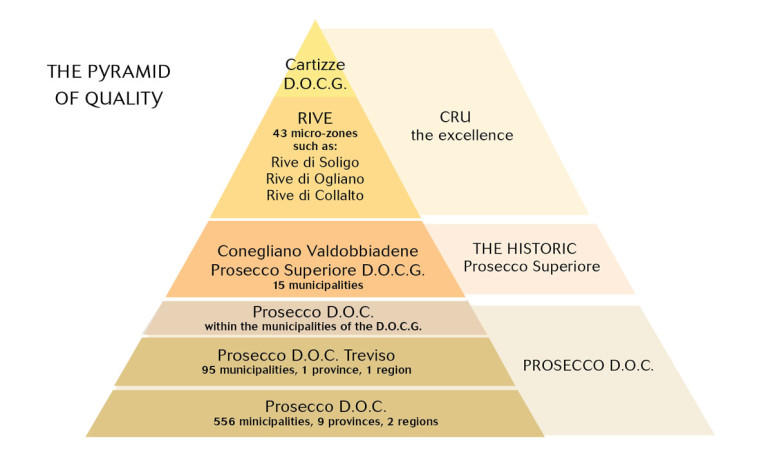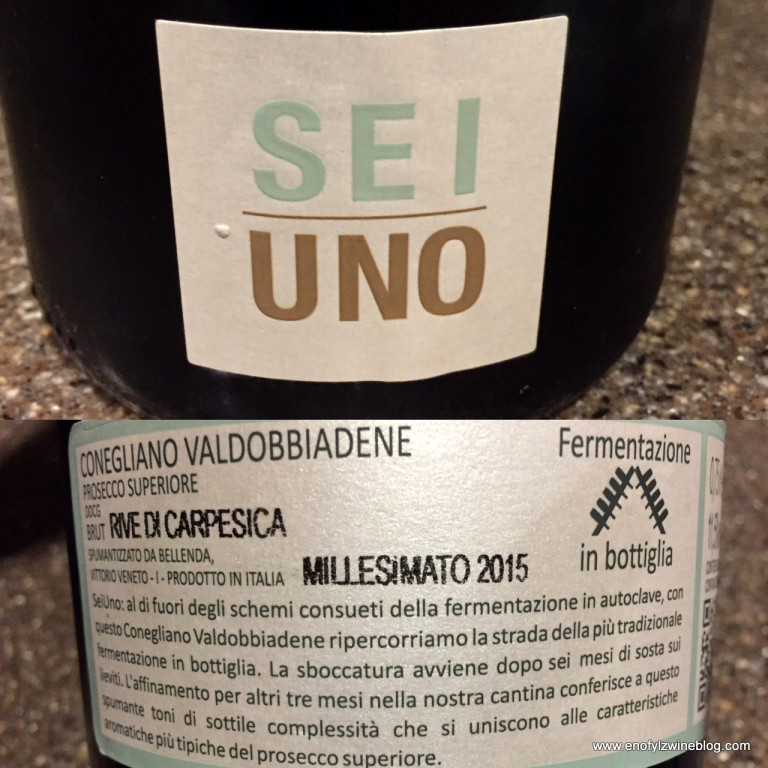During the month of October, I’m participating in the #winestudio Conegliano-Valdobbiadene (“CV”)program.
The four-week program features a region, that until last year, I was unfamiliar with.
While attending the 2016 Wine Bloggers Conference, I attended a session put on by the Consortium of Italian Wine and Food. One of the wines, I tried was a Conegliano Valdobbiadene Prosecco Superiore DOCG . It was the Masottina Rive di Ogliano (coincidentally, a wine featured in Week 2 of the program – see schedule below). It was a memorable wine with more character and depth than almost any Prosecco that I’d had before. In fact, the only other comparable Prosecco I’d had was from Sorelle Bronca, which is also from Valdobbiadene (though I didn’t realize it at the time) ! With those experiences in mind, I jumped at the opportunity to participate in the October program and learn more!
- Week 1, held October 3rd was an overview of Conegliano Valdobbiadene (Click here to read my post)
- Week 2, held October 10th was about the Rive sub-category of Conegliano Valdobbiadene (Click here to read my post)
About Conegliano Valdobbiadene
The area of Conegliano Valdobbiadene lies in hilly countryside situated 50 km from Venice and around 100 km from the Dolomites. Here vine-growing has extremely ancient origins, but the first written document linking Prosecco to this area dates back to 1772. Ever since the introduction of the D.O.C. in 1969, the historic production area has remained limited to just 15 communes. Two of these give it its name: Conegliano and Valdobbiadene, one being the zone’s cultural capital and the other the heart of its production.
Due to its complex, extremely diverse and dramatic terrain, long viticultural history and hand-crafted nature, the Conegliano Valdobbiadene has the potential to produce wines of particular interest and diversity closely tied to the place of origin.- Alan Tardi, US Ambassador of ConVal Prosecco DOCG
The vineyards are situated an altitude of between 50 and 500 meters above sea level with abundant southern exposure on stony, glacial-era morainic subsoil. With a breeze that arrives from the Adriatic to the east, the Conegliano-Valdobbiadene region offers ideal conditions for producing fresh wines with vibrant acidity and signature minerality.
The sparkling wines of the region may be labeled as either Valdobbiadene (generally preferred because it is perceived to be more prestigious), Conegliano, or both.
The region is currently shortlisted for inclusion as a UNESCO World Heritage Site.
Conegliano Valdobbiadene Prosecco Superiore D.O.C.G. At A Glance
Soil Types: Conegliano – Primarily clay and limestone with a mix of alluvial and glacial deposits; Valdobbiadene – Mix of moraines, sandstone and clay
Grapes planted: Glera is the predominant grape; but Verdiso, Perera, Bianchetta
Styles: 95% is Spumante ( fully sparkling); Frizzante (fizzy) which is less bubbly; and Tranquillo, a still wine
Production Method: Martinotti Method (a.k.a “Charmat” method outside of Italy) whereby secondary fermentation takes place in pressurized steel tanks known as autoclaves.
Sub regions: DOCG, DOCG Rive and Cartizze (see Prosecco quality pyramid below)
Levels of Sweetness : Brut, the driest style, Extra Dry, the most traditional, and Dry, with a higher level of residual sugar.
Production: Only 25% of Prosecco produced earns the DOCG designation
Graphic courtesy of Conegliano-Valdobbiaden Prosecco Superiore DOCG
Quality Levels of Prosecco
As you can see from the quality pyramid below, if Cartizze is the “Grand Cru” of Prosecco, then the Rive are the Premier Crus of Prosecco.

Methodo Classico and Col Fòndo In Conegliano-Valdobbiadene
While the vast majority (~95%) of Prosecco is made in an autoclave, second fermentation in the bottle is still permitted under the DOCG guidelines, either in a traditional process known as Col Fondo (in which the sediment is left in the bottle) or Metodo Classico with sediment removed. In CV the official term is Rifermentato in Bottiglia (Refermented in Bottle).
Col Fondo
Col Fondo is an unfiltered, lightly effervescent, bottle-fermented (rather than autoclave) expression of prosecco. It is noticeably drier, yeastier, and more savory than conventional crisp, clean and fruitier version of the wine.
Since ancient times, when…current autoclave (pressurized tank ), didn’t exist, Prosecco was bottled with its own yeasts, and then it was placed to rest in the house’s cellar. During this period refermentation took place in the bottle, remaining sugars turned into twisting bubbles, and so the Prosecco , after a few months, became fizzy. The wine was ready to be tasted with its own refermentation’s yeasts, which were lying at the bottle’s bottom, that’s where the name “Col Fondo” comes from ( Sur-lie ). – Azienda Agricola MALIBRÁN
The first time I saw a bottle of wine labeled “Col Fondo” was a couple of months ago while I was in a wine shop in Portland. I thought it was the Italian version of a pétillant-naturel or pet nat as it is affectionately known in English-speaking countries.
It’s not. The difference is that pet nat wine is bottled before fermentation is complete. On the other hand, the base wines for col fondo wines are completely fermented before being bottled and the second fermentation is carried out in the bottle.
Metodo Classico
Metodo Classico is the same method as the méthode champenoise in Champagne, and most other traditional sparkling wines such as Cava, or Cremant. It is widely regarded as the highest quality technique.
After the wine undergoes a secondary fermentation in bottle (rather than autoclave), Prosecco crafted this way tend to have finer bubbles and yeasty aromas are more pronounced. The difference between Col Fondo and Metodo Classico is that Col Fondo wines are not filtered and Metodo Classico wines are filtered
Wines Tasted
2015 Bellenda Conegliano Valdobbiadene Prosecco Superiore DOCG Brut “Sei Uno” Rive di Carpesica

“Rive” in the Conegliano region!
Tasting Notes
Color – Very pale yellow
Aromas – Golden apple, hazelnut, brioche, chalk and a hint of citrus
Body – Light-bodied, and refined with a soft, delicate mousse. Also noticed the bead was different from previous Prosecco tried. Not sure if it was my glass or the wine
Taste – Ripe peach, mandarin orange, calamansi, roast hazelnut
Finish – Long
90pts – Outstanding; 11.5% ABV; Residual Sugar; 4.13 g/L
This Conegliano Valdobbiadene sparkling wine, departing from the normal Italian method refermentation, adheres to the more classic refermentation in the bottle method. After the wine spends a number of months sur lie, the wine is disgorged and receives a further six months ageing in the cellar.
2015 Malibran Valdobbiadene Prosecco DOCG “Credamora” Rifermentato in Bottiglia

Tasting Notes
Color – Hazy pale golden yellow
Aromas – Autolytic (yeasty); Initially apple cidery aromas dominate, and there’s a bit of green pear and hint of white flower aromas. After decanting for about 45 minutes, bread crust, white peach, and lemon cream join the party.
Body – Medium-bodied with mouthwatering acidity. It’s lightly sparkling and broad on the palate
Taste – Green apple, Asian pear, white peach, lemon, and a hint of mandarin orange along with a very appealing saline minerality
Finish – Medium and savory.
91pts – Outstanding; 11% abv; Zero sugar; SRP- $23
My Takeaways
I’m amazed that I’ve enjoyed the CV Prosecco wines more each week (the Malibran Credamore Col Fondo blew me away) ! They are high-quality, exciting wines at remarkably affordable prices! I think my tweet says it all!
Amazing wines! I’ve been schooled and I’m loving it. Honestly this #winestudio has brought me back to Prosecco! (make that #ConValDOCG) https://t.co/2g6JUKumum
— Martin Redmond (@martindredmond) October 18, 2017
About #winestudio
#winestudio is a wine education program produced by Tina Morey. Its message is interactive wine education, thus a better understanding of our world through wine and our part in that world. Questions and comments are encouraged! You can become involved in the #winestudio conversation through Twitter, Facebook and Instagram and meet new wine folks from all over the world!
The October Conegliano-Valdobbiadene program is about painting a picture of the history, terroir and people associated with this Prosecco Superiore D.O.C.G zone.
The schedule is:
- Week 1 October 3 – Prosecco DOCG – History of Conegliano Valdobbiadene
- Week 2 October 10 – Rive sub-category of Conegliano Valdobbiadene
- Week 3 October 17 – The Second Fermentation: Bottle vs. Autoclave in Prosecco Conegliano Valdobbiadene
- Week 4 October 24 – Cartizze – The “Grand Cru” of Conegliano Valdobbiadene
Join the conversation by following #winestudio hashtag on Twitter on Tuesdays. We’re live from 5:45 pm – 6:45 pm Pacific on Tuesdays in October!
________________________________________________________________________
Follow me on Twitter, Facebook, Instagram, Vivino and Delectable, for all things wine. As a wino with latent foodie tendencies, you’ll also find food and wine pairings, and food related stuff! Become a fan and join ENOFYLZ Wine Blog on Facebook. Cheers!
Copyright Notice: This entire site is Copyrighted 2010-2017. All Rights Reserved. No unauthorized copying of any section of this site is permitted. If you wish to use any part of this site, contact me. For information on Copyright Law, see the official U.S. Copyright Office home page.